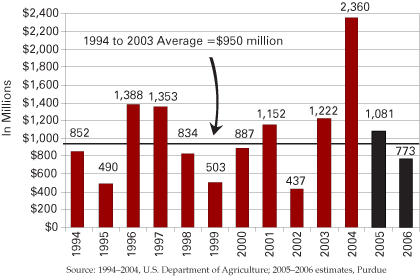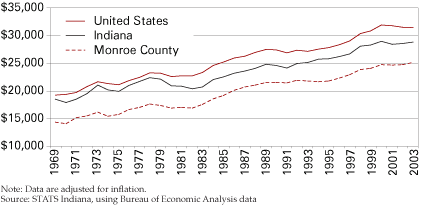Indiana Agriculture
Department of Agricultural Economics, Purdue University, West Lafayette
Where is the Indiana agricultural economy headed in 2006? The answer is toward weakening income and increasing (though at a slower pace) farmland values.
Let’s start with net farm incomes. Part of the reason farm incomes seem low is the extraordinary income levels of nearly $2.4 billion in 2004. The previous record incomes were near $1.4 billion in 1996 and 1997. Thus, Indiana’s net farm income in 2004 was 70 percent higher than the previous record. To put $2.4 billion of income in perspective, the average yearly income for the previous ten years, 1994–2003, had been around $1 billion (see Figure 1).
Figure 1
Indiana Net Farm Income in Actual Dollars, 1994 to 2006

Since 2005 data are not currently available, Purdue estimates much more modest incomes between $1 billion and $1.1 billion. While down sharply from 2004’s record, many Indiana crop farmers feel fortunate to have seen their income prospects recover with good yields after a hot, dry summer. Crop yields in 2005 are expected to be slightly below normal for corn and slightly above normal for soybeans. Costs of crop production were up sharply in 2005, cutting into farmer margins. Livestock, milk, and poultry prices are somewhat lower than 2004 as well. Large variations in individual farm incomes can also be anticipated given wide ranges in yields from farm to farm across Indiana this fall.
Finally, what about 2006? At this early point, we see continued sharp increases in costs of crop production led by fuel and fertilizer costs, plus interest rate increases. Unfortunately, crop prices are not expected to rise by enough to cover these surging costs. The outlook for the animals sector turns down as well, with 2006 prices dropping for beef cattle, hogs, milk, and turkey. The only good news for livestock producers is that feed costs will be lower. Purdue’s estimates of Indiana’s 2006 net farm income suggest further declines to a below average income between $700 million and $800 million. With record-high land values and cash rents, surging input costs, and struggling grain prices, 2006 looks to bring a severe cost/price squeeze for crop farmers and narrowing returns for animal producers.
Where are agricultural land prices and cash rents headed in 2006? Let’s start by reviewing what happened in 2005. According to the Purdue Land Value Survey, Indiana farmland values reached record highs again in 2005 at an average value of $2,945 per acre (see Figure 2). This 9 percent increase was the latest in a series of increases that started in 1987. Cash rents also edged upward to $126 per acre, an increase of 3 percent.
Figure 2
Indiana Agricultural Land Values and Cash Rents per Acre

Looking toward 2006, we expect farmland values to continue to increase until long-term interest rates increase. Because long-term interest rates are projected to increase in 2006, farmland values are expected to increase at a slower pace, only 4 to 6 percent. There are three other factors that would derail a continued increase in farmland values.
- If the 2007 farm bill reduces government price support payments.
- If rental income is reduced because of continued pressure on margins from either production cost increases or price declines.
- If real estate taxes increase.
The demand for land to rent remains strong as farmers seek to increase the size of their operations. However, crop margins for 2006 are projected to be very tight, which will limit the ability of tenants to pay higher rent. Therefore, we expect cash rents to only increase 0.5 percent to 1 percent in 2006.
The financial condition of the Indiana farm sector is the strongest since the 1960s due to strong income performance in 2003, 2004, and 2005, and record-high land values that keep asset values high. However, changes appear to be coming for some in the agricultural community in 2006. Landowner wealth is high, but tenants have not shared as strongly in the good fortunes.
In 2006, tenants will be caught in a struggle to cover the escalated input costs, higher rents, and higher interest costs with little ability to improve revenues. Margins may be negative and will provide incentives for tenants to reduce input use somewhat, cut back on capital purchases, seek concessions on cash rent, and cut their family living expenses as they struggle through the year and hope for a change in prospects in 2007.
One trend that may improve future prospects comes from the energy sector. The energy bill requires that 7.5 billion gallons of renewable fuels be used by 2012, with the most likely candidates being ethanol made from corn and biodiesel made from soybean oil. Demand from the energy sector for corn and soybeans has the potential to improve prices and incomes, positively influencing farmland values and cash rents.
Also in this Issue…



